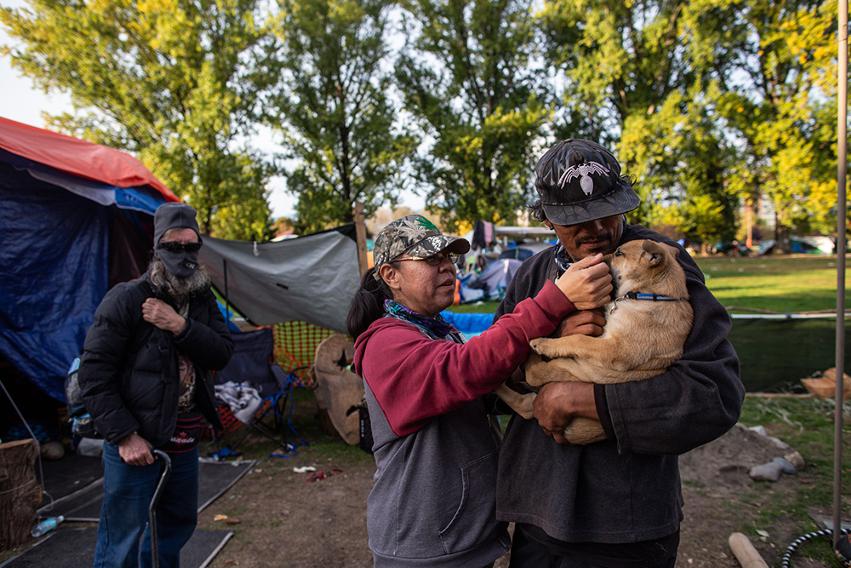Last April, in an alley just off East Hastings Street in Vancouver, an angry voice called out from behind me.
“Hey, what are you doing with those cameras?”
I turned around to see two men and a woman sitting together, leaning against the wall. Several Naloxone kits were laid out on the ground, alongside needles and other drug paraphernalia.
At the time, the first COVID-19 wave was cresting across the province, and the rate of fatal overdoses from a toxic street drug supply was rocketing skyward.
“I work for a news agency,” I replied, walking towards the trio. I left my cameras dangling at my sides. “I’m working on a story about the new safer-supply program.”
One of the three stood up and stepped towards me, the tension in his shoulders easing. He said someone else had just come through the alley, filming everything on his phone without saying a word, and it pissed him off.
“So what’s this story you’re working on?” the guy asked. I explained a little more about the issue, and that I was looking for people who had accessed safer-supply prescription narcotics, or might want to.
The man, who declined to give me his name, said he hoped to get on the program soon, because the street drug supply he relied on was so dangerous. I asked if I could make a few photos of the three of them.
“Sure, go ahead,” the man said. “People need to see this shit.”
I spent a few minutes making pictures and chatting with them, said thanks, then headed off. As I was leaving, the woman called out. “Thanks for asking first,” she said.
The past year saw unprecedented levels of anxiety, pain, heartache and trauma across the province. Amid the COVID-19 pandemic, 2020 also saw dizzying spikes in fatal overdoses.
Pandemic restrictions put immense pressures on communities already struggling with a housing shortage, a toxic drug supply and a mental health-care system that leaves too many people floundering in crisis.
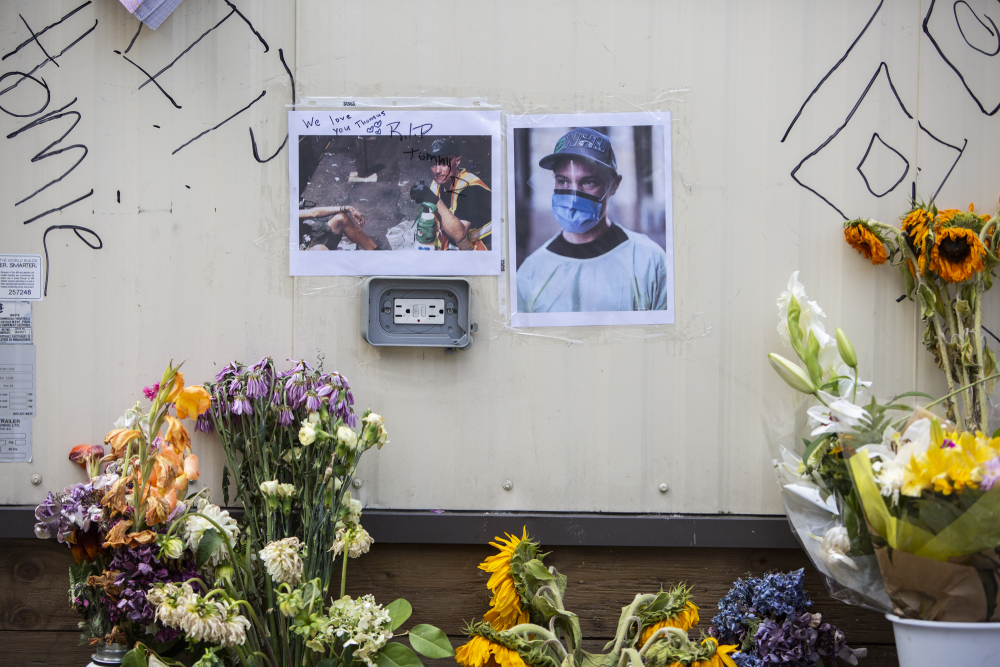

It’s said that seeing is believing. As photojournalists, it’s our job to document these struggles and help the public understand them. But as these intertwined crises drag on, I wonder whether we’re doing a good enough job.
There’s no shortage of imagery now about overdoses, and there are huge piles of photos of homelessness, tent cities and street disorder. Yet chronic misconceptions about all these issues persist, and may even be worsening.
We need to start asking ourselves what we’re seeing and — by extension — what we’re believing.
There’s an expression that photojournalists use: “f/8 and Be There.” It’s a reminder that we have to be out in the world, where the story is, when it happens.
Unlike reporters, we can’t reconstruct scenes after the fact. We can’t create images over the phone. If we miss the moment, we’ve missed the story.
But on issues of poverty, marginalization and substance use, it is getting harder and harder for us to do our jobs, for two reasons.
The first is that the authorities that run much of the programming in Vancouver’s Downtown Eastside frequently restrict access to their programs, sometimes to absurd degrees. It’s an often-paternalistic approach that denies their clients the chance to decide for themselves whether they want to be a part of news coverage.
As community activist Karen Ward told me, “I can’t remember the last time I saw the inside of an overdose prevention site in a news story.”
This is a problem because if the public can’t see what happens in these spaces, they can’t understand it. As Ward noted, nearly two decades after Insite first opened, misconceptions about supervised consumption sites being full of chaos and depravity still abound.
These agencies tell us the restrictions are about client privacy, and in some cases that is a serious concern.
At an overdose prevention site in particular, the presence of a stranger with a camera could scare clients away, preventing them from accessing a potentially life-saving service. The need to be cautious and ethical is real, and it takes experienced, professional photojournalists to safely navigate these issues.
But the same thing happens in single-room occupancies, or in modular housing: anywhere that government or public agencies are involved, it is often difficult or impossible for photojournalists to capture a real, natural moment.
The only alternative they offer us is to occasionally photograph in these spaces when they are closed, when no clients are present, or when they’ve attached an agency minder while we photograph what are essentially staged events.
They handpick the clients and choose the time of our access to minimize the chance that we’ll see something that will embarrass them. It takes days or weeks to arrange these opportunities, meaning they are not possible on tight deadlines or when news is happening.
This past year was worse than most, as the twin forces of pandemic restrictions and bureaucratic timidity combined to restrict access almost entirely. Shut out of many of the places the public needs to see, we’re forced to make do with what’s available “in public” — out on the street — or rely on recycled generic file images of tents, needles and pills.
The problem with this is that it’s too easy, too alluring. Photographers can cruise down East Hastings taking photos on the sly with a telephoto lens, without ever having to speak to anyone.
We’ve all done it at one point or another. But it’s based on the misguided belief that photographing an end result of broken social systems is a good enough way to represent the issue as a whole. It reduces the entire community to what can be seen from the sidewalk.
It also robs people of agency and control over how their images are used, and where. Those of us who are housed always have a refuge we can return to where we have a legally-protected expectation of privacy. Photojournalists can’t just peer into backyards or living-room windows.
But for people experiencing homelessness, the public park might be their backyard. A doorway might be their living room. People forced into public spaces by circumstances largely beyond their control deserve the same expectation of privacy as everyone else, and slyly snapping their photo with a telephoto lens so they can be reduced to a symbol for a story does a disservice to them, and to the reader.
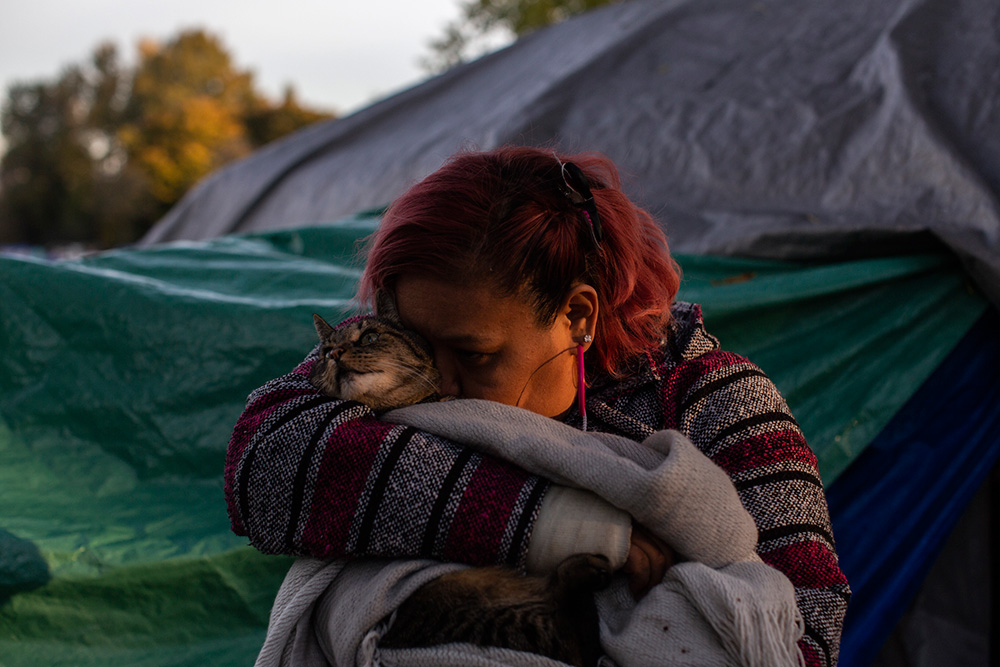

As photojournalists, our job is to hold up a mirror so we might all better understand our communities, and ourselves. The painful outcomes of failed or failing public policy must be reflected. Sometimes that means photographing people on the worst day of their lives, especially if that day takes place in public.
But when we rely on photographing only the pain, showing only one element of complex issues like housing affordability, mental health or substance use, the mirror gets broken. The public sees only a tiny shard of the whole mirror, and it’s that shard that helps determine what they believe.
We saw this with the issue of street disorder in Vancouver this year. No one would seriously dispute that street disorder increased as a result of pandemic restrictions, the increasingly toxic drug supply and many other compounding factors.
But in the news media, anonymous scenes of street disorder too often become a visual shorthand used to cast blame on whatever social failure we’re writing about that day, simplifying the narrative to sometimes dangerous degrees.
Most of this happens not because photojournalists are lazy, unethical or malicious. It happens because it can feel like there’s no alternative. Deadline pressure, a lack of access and dwindling resources have left most newsrooms stuck in a “make-do” mentality, and visual journalism is often the last need considered or the first thing to be cut.
As a local reporter friend told me, for every deeply-reported human story there are a dozen picture-less government press releases, academic reports or other news items that have to be written up and published on deadline. That creates immense pressure on newsrooms to find something — anything — to put atop their stories.
But as photo departments across the country have been gutted, the visual literacy needed to make the right call has plummeted, replaced by a belief that in most cases, any photo will do.
Karen Ward is working on one novel solution to this problem. Recognizing that there will always be a need to illustrate more stories than there are photographers, she’s working on a project to create a library of publicly-available photos from the Downtown Eastside that better reflect the community and its reality.
“We need media so badly not just about us, but with us,” she said.
During last year’s provincial election, we saw stigmatizing imagery weaponized not by journalists, but by groups of “concerned citizens” who encouraged each other to actually target people on the street, using photos and videos to harass and shame people struggling within a myriad of systemic failures, all under the guise of “documenting” what was happening “in public.”
It was disgusting and shameful, but outlets still used the material in their stories and broadcasts, sometimes without even vetting it or the people who created it. This kind of free “poverty tourism” content, as Ward describes it, is becoming common and tempting for news outlets strapped for time and resources.
But consider the result: in November, after a summer’s worth of debate about defunding and reducing unnecessary police contact with marginalized communities, the Vancouver police instead created an entirely new unit to respond to the issue of “street disorder.” The change wasn’t based on evidence, but on their own survey gauging the public’s perception of the issue — a perception driven in large part by this weaponized imagery.
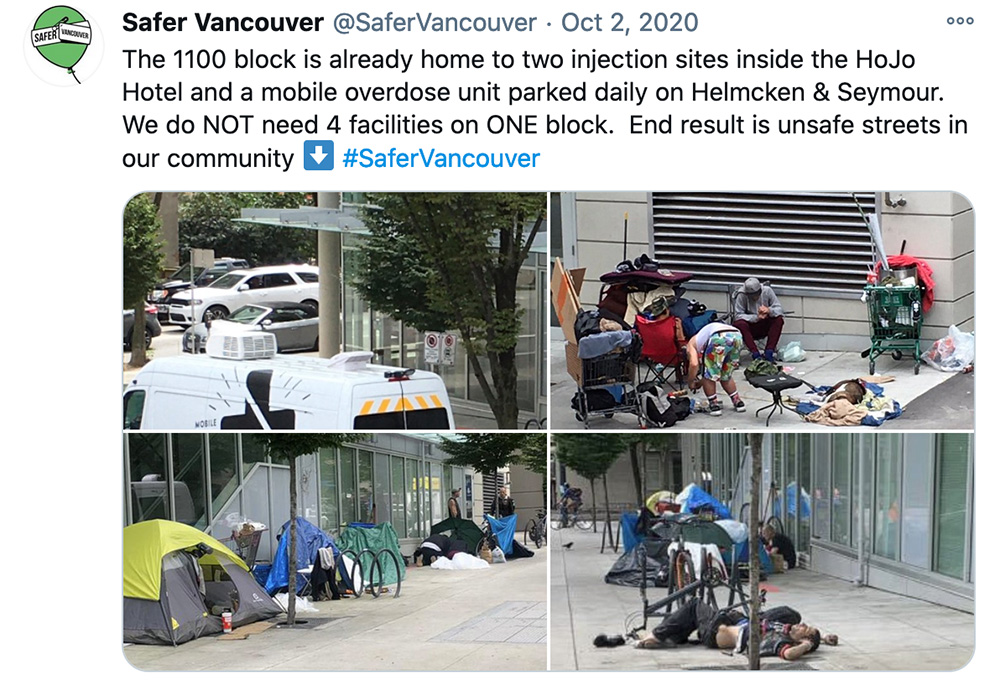
When news outlets don’t pick the low-hanging fruit of anonymous street-disorder scenes, the reliable fallback is stock photos with an increasingly tenuous connection to reality.
One example Ward points to is an image she calls Needle-in-Puddle. It’s a CBC archive photo of a hypodermic needle in a rain-filled gutter. It’s been around since at least 2018 and was created amid a public debate about the need for more public syringe collection boxes.
But since then, it has been recycled dozens of times for stories about the overdose crisis in general and, in particular, the monthly overdose death updates.
As Ward points out, there are several problems with this. First, an increasing percentage of overdose deaths result not from injecting drugs, but from inhaling them. Reusing a needle photo skews the public’s understanding of the causes. It’s also impossible to know whether needles found discarded on the street were used to inject narcotics, insulin or life-saving Naloxone, and the distinction matters.
Second, for Ward the photo has an obvious tone. When it appears under a headline about another record number of deaths, the implication is one of hopelessness, she says.
“It’s not the death Olympics,” Ward says. “It shouldn’t be about breaking records, but Needle-in-Puddle says, ‘This is just how it is.’ It’s a cliché that’s empty of meaning.”
Ward says the same is true of a Canadian Press image I’ve dubbed “Pile-’o-Pills.” Generic photographs of prescription drugs dumped on a table, assumed but not always marked as narcotics, imply that users are out there swallowing handfuls of the things and overdosing when, in fact, a mounting body of research demonstrates that prescription alternatives are far safer than illicit street drugs, and easier access to them for people at risk of an overdose can save lives.
With every recycling of a file image, what began as a fact-based document of a moment in time eventually becomes nothing more than a symbol, and its usefulness is based more on assumptions and clichés than on fact.
Strip away the original caption, which often happens, and the photo becomes even more meaningless scaffolding upon which to build whatever presumptions the reader might bring to the story.
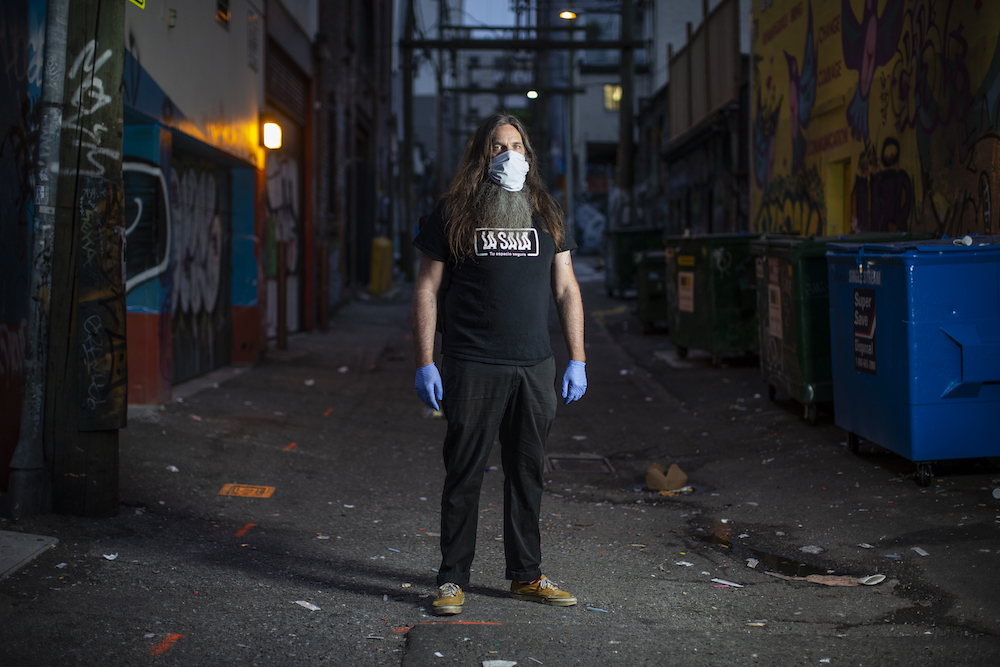
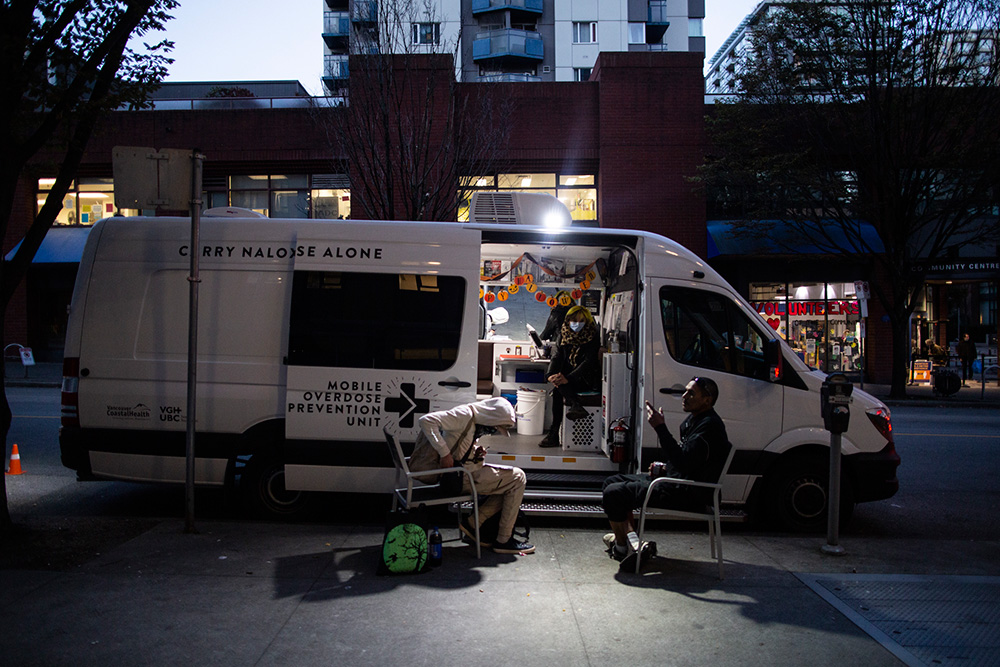
So what do we do?
Firstly, we need to remember that these are stories about ongoing public policy failures. They are not about the morality of people struggling in broken systems, and they certainly aren’t entertainment. As Ward told me, the Downtown Eastside “is not a backdrop for your Instagram selfies.”
These stories are, at their heart, human. By finding and showcasing the humanity and complexity of the people impacted by these ongoing failures, we can help keep the focus where it needs to be.
We also need to showcase efforts to make things better. “Solutions journalism” doesn’t mean producing fluffy feel-good success stories; it means taking as hard and critical a look at what is working as we do it and what is not.
In order to do this, photos need to be treated not as adornments for stories, but as integral parts of them. When used appropriately, photography has an incredible power to connect people, to make things real for readers, to make people stop and pay attention.
There’s another idiom I lean on often: “If your photos aren’t good enough, you’re not close enough.” I take this to be more metaphorical than literal. A good photo doesn’t just depict what a person looks like, it reveals their humanity.
Creating images like that means earning the trust of the people we’re photographing. They need to know that their story has value, and why it matters to us that we help tell it.
We need to preserve and showcase their dignity. They should understand where and how their images might be used, and outside of breaking news events, they should be given the agency to decide for themselves if they want to participate.
This piece was originally published by the Tyee and appears here with permission.

